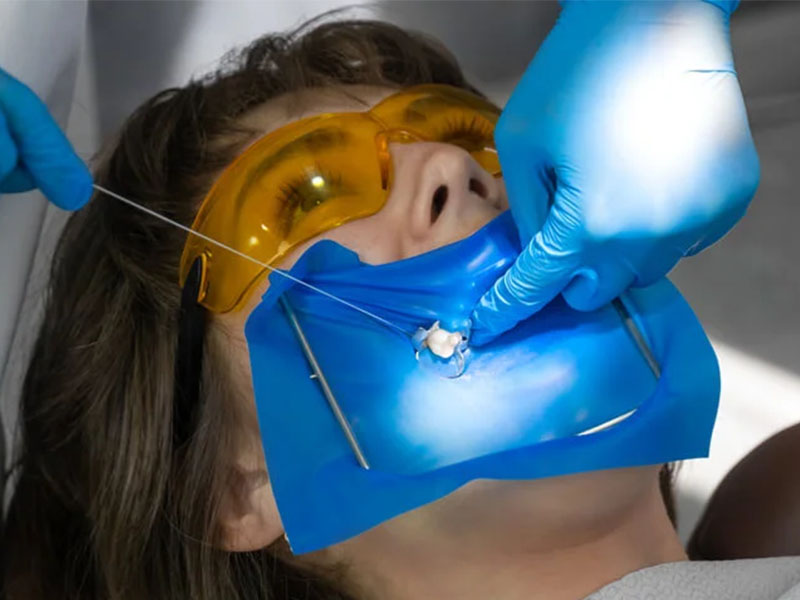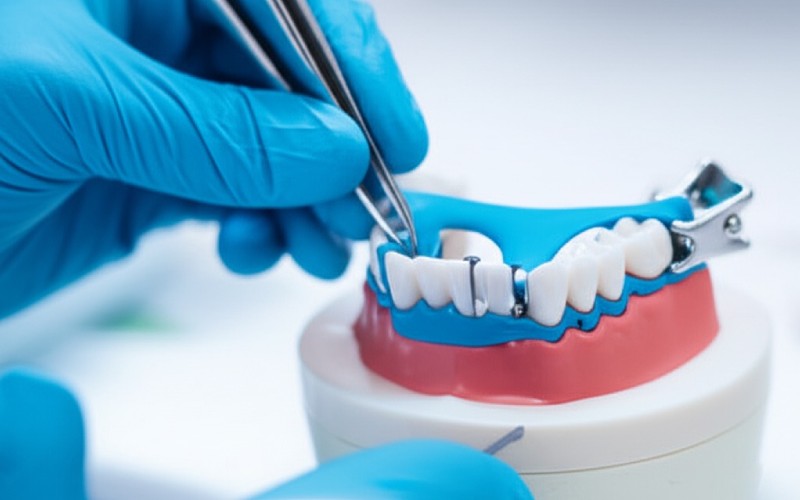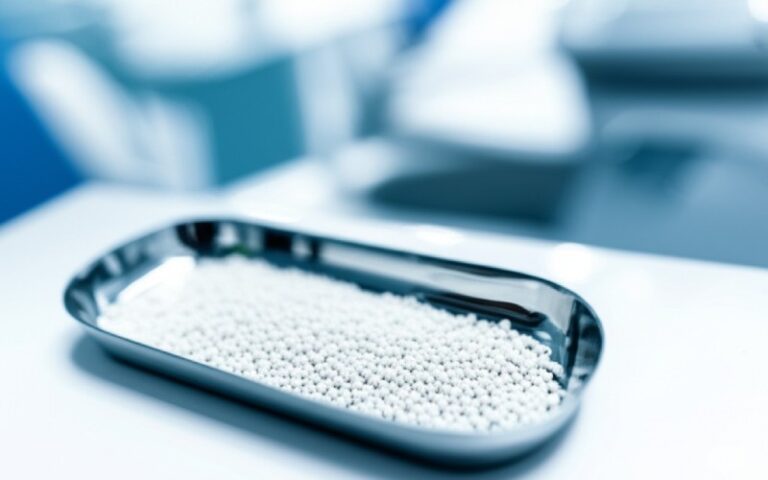
Unlock Better Dental Results: The Power of Rubber Dam Isolation for Restorative Treatment
The rubber dam is a thin sheet of rubber. But its impact on restorative treatment in dental patients is huge. It is the best way to keep a tooth clean and dry during a dental procedure. This is called isolation. In this article, I will share everything you need to know about rubber dam isolation. You will learn why the use of a rubber dam is so important for your health and the success of your dental work. This guide will show you why dam isolation for restorative treatment is the gold standard.
Table of Contents
What Exactly Is a Rubber Dam, and Why Should I Care?
A rubber dam is a simple square sheet. It is usually made of latex or a material called nitrile for people with allergies. Think of it as a small raincoat just for your tooth. During a dental treatment, the dentist makes a tiny hole in the sheet. Then, they slip it over the tooth they need to fix. This separates the tooth from the rest of your mouth. This process is called rubber dam isolation. The goal is complete isolation of teeth.
You should care because this simple sheet makes your dental treatment better and safer. The main purpose of using a rubber dam is isolation. When a dentist works on a tooth, it must be perfectly dry. Saliva has germs and moisture. If saliva touches the tooth, fillings or crowns might not stick well. This can cause them to fail later. The rubber dam keeps the area totally dry. This is a key part of good restorative treatment in dental patients. The use of rubber for this purpose has been a major step forward in dentistry. The rubber dam materials are designed to be strong and flexible.
How Was the Rubber Dam Invented?
The story of the rubber dam is quite old. It was introduced to the dental profession back in 1864. A New York dentist named Dr. Sanford C. Barnum came up with the idea. He was trying to place a gold filling, but the tooth kept getting wet. He grabbed a piece of rubber, cut a hole in it, and stretched it over the tooth. It worked perfectly. The tooth stayed dry, and he could do his work.
This simple invention changed dentistry forever. Before the rubber dam, dentists struggled to keep teeth dry. They used cloths and other simple tools. The use of rubber was a revolution for isolation in dental work. Dr. Barnum shared his idea freely with other dentists. Because of him, the use of rubber dam became a key technique. For over 150 years, the rubber dam has helped dentists provide better care. It proves that sometimes the simplest ideas are the best ones.
What Are the Main Benefits of Using Rubber Dam Isolation?
The benefits of using rubber dam isolation are huge for both you and the dentist. For you, the patient, a rubber dam provides safety and comfort. It acts as a shield. It keeps water spray, filling pieces, and other small things from falling to the back of your throat. You don’t have to worry about swallowing anything. The rubber dam also protects your tongue and cheeks, keeping them safely out of the way. This can reduce your stress during the dental procedure.
For the dentist, the benefits lead to better quality work. The effect of rubber dam is clear. It provides a clean, dry, and visible area to work. This makes the dental treatment more efficient. The dentist can see better and doesn’t have to fight with your tongue or cheek. This perfect isolation is critical for modern dental materials. Good isolation from a rubber dam means your fillings and crowns will last longer. The benefits that rubber dam include make it an essential tool. The main effect of rubber dam usage is a higher standard of care.

Is a Rubber Dam Better Than Cotton Rolls for Isolation?
This is a common question. Many people have only seen cotton rolls used for isolation. So, how does a rubber dam versus cotton roll stack up? A rubber dam is much better. Cotton rolls get soaked with saliva very quickly. They need to be changed often during a dental procedure. This can interrupt the dentist and allow moisture to touch the tooth. Cotton rolls as the isolation method is not very effective for long procedures.
The debate of rubber dam and cotton roll has been studied a lot. A rubber dam provides complete and lasting isolation. It keeps the area dry for the entire time. The effect of rubber dam versus cotton roll isolation is clear. A rubber dam stops all moisture. This is not possible with cotton rolls. When comparing dam and cotton roll isolation, the rubber dam is the clear winner for quality. Using rubber dam or cotton rolls is a choice, but the best isolation method is the rubber dam. We can look at the effects of rubber dam versus dam versus cotton roll isolation methods. A rubber dam compared with cotton is simply superior. The use of rubber dam is better than rolls as the alternative isolation method.
What Happens During Rubber Dam Placement?
You might worry that rubber dam placement is complicated or uncomfortable. But it’s a fast and easy process for a trained dentist. First, the dental team picks a suitable rubber dam sheet for your mouth. They use a special punch to make a small, precise hole in the sheet for the tooth that needs work.
Next, a small metal clip, called a rubber dam clamp, is placed around the tooth. This clamp gently holds the rubber dam in place. Then, the dentist stretches the rubber dam sheet over the clamp and the tooth. The tooth pokes through the hole. A frame is used to hold the edges of the rubber dam away from your face. The whole rubber dam technique takes only a minute or two. Once the application of the rubber dam is done, you can relax. The rubber dam is now placed around your tooth, and the real work can begin.
Does Using a Rubber Dam Make Dental Treatment Safer?
Yes, absolutely. Safety is one of the biggest reasons for rubber dam usage. The rubber dam acts as a perfect rubber dam as a barrier. It creates a wall between the tooth being worked on and the rest of your mouth. This prevents you from accidentally swallowing or breathing in small bits of old fillings, tooth dust, or other materials. It is a critical safety measure.
The use of a rubber dam also improves infection control. During a dental treatment, water spray creates a mist called an aerosol. This mist can carry germs. A rubber dam greatly reduces this mist, protecting both you and the dental team. The effect of the rubber dam on safety is a huge plus. Some studies look at parameters of stress during dental treatment. A rubber dam may help you feel more secure, knowing you are protected. The rubber dam on objective stress during dental treatment shows it can help patients relax.
Can a Rubber Dam Improve the Quality of My Dental Work?
The quality of your dental work depends heavily on the isolation method. The influence of rubber dam isolation on quality is huge. Many modern dental materials, like white fillings and bonding agents, are very sensitive to moisture. If even a tiny bit of saliva or blood touches the tooth, the bond can be weak. This can cause the filling to leak, get new decay under it, or even fall out.
The use of rubber dam isolation ensures a perfectly dry tooth. This helps your restoration last as long as possible. The influence of the isolation method on the performance of a filling is well known. Studies have shown a better survival rate of dental restorations when a rubber dam is used. Direct restorative treatments in dental work need good isolation. The influence of rubber dam isolation on the performance of dental work is positive. Rubber dam isolation during restorative treatments is the best way to get a great result. This isolation and moisture reduction technique is key.
Are There Any Downsides to Using a Rubber Dam?
While the rubber dam still has numerous benefits, there are a few small downsides to consider. Some patients feel a bit closed in or claustrophobic with the sheet over their mouth. However, the dentist can help you feel comfortable. You can breathe normally through your nose. If you have a stuffy nose, let the dental team know.
Another issue can be a latex allergy. But this is easily solved. Non-latex rubber dam materials are available in every modern dental practice. The other concern some dentists have is the extra time for application of the rubber dam. But many dentists find that the treatment time when using rubber dam is actually shorter. This is because they can work faster and without interruptions once the rubber dam is on. We must also think about the negative effects of different isolation and moisture control techniques. Using cotton rolls as the isolation method can be less comfortable in the long run.
What Does the Research Say About Rubber Dam Usage?
The science is very clear. Many studies have been published in places like the Journal of the American Dental Association. This research supports the routine use of rubber dam. For example, one study by the International Association for Dental Research evaluated the effects of rubber dam isolation. It found that fillings placed with a rubber dam lasted longer. The research has been done for many years in favour of rubber dam usage.
Another report from the National Center for Dental Hygiene Research & Practice looked at different isolation methods in dental restorative treatments. The conclusion was that dam isolation for restorative treatment is superior. Studies assessing the effects of rubber dam usage on different types of fillings show better outcomes. Research from the Journal of the American Dental Association has indicated that rubber dam usage improves the quality of care. The effects of the isolation methods on the performance of restorations is a big topic. The International Association for Dental Research confirms the benefits.

Why Don’t All Dentists Use a Rubber Dam?
If the use of rubber dam is so good, why isn’t it used every single time? There are a few reasons. Some dentists feel that rubber dam usage takes too much time. They may prefer a faster isolation method, like cotton rolls. Some may not have received enough training on the best rubber dam technique and find it difficult. This can lead to never using a rubber dam.
However, many experts believe the benefits of dam isolation during restorative treatments are worth the extra minute. The use of rubber is a skill, and it gets faster with practice. The Journal of the American Dental Association often talks about the importance of this tool. The push for high-quality care means that rubber dam usage in improving dental outcomes is becoming more common. Choosing a dentist who uses a rubber dam can mean you are choosing a higher standard of care for your restorative treatment in dental patients. The use of rubber dam might be a good sign of a quality dental practice.




